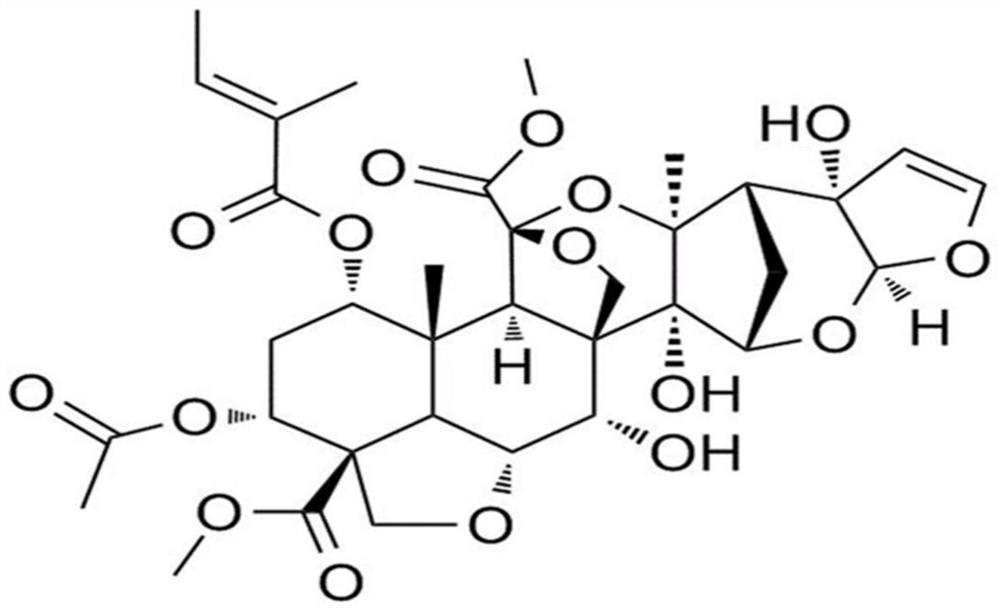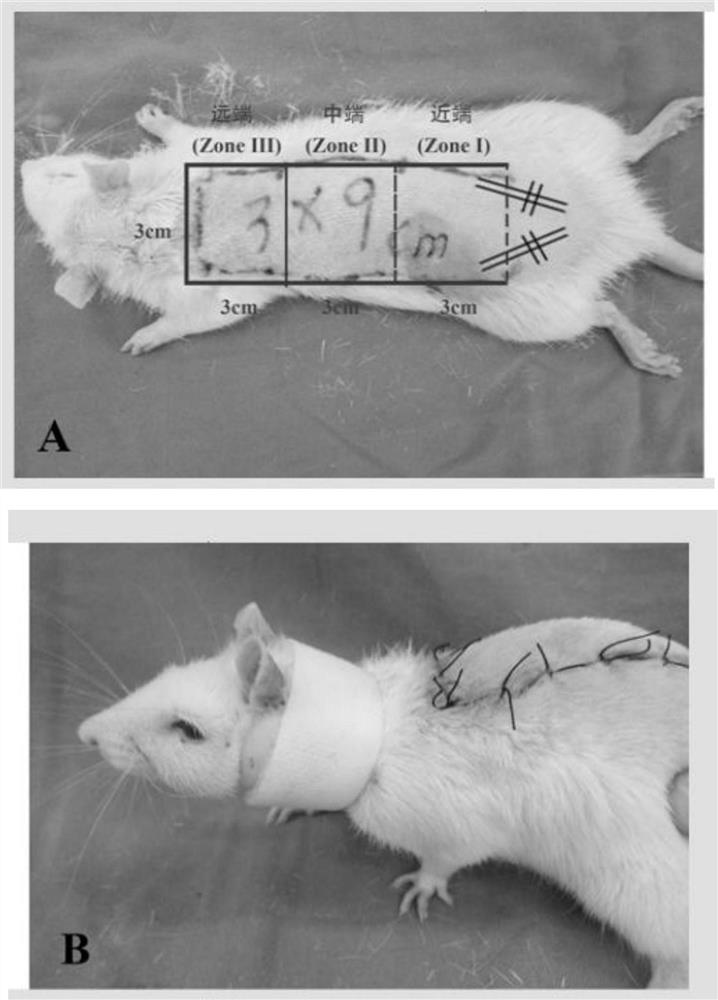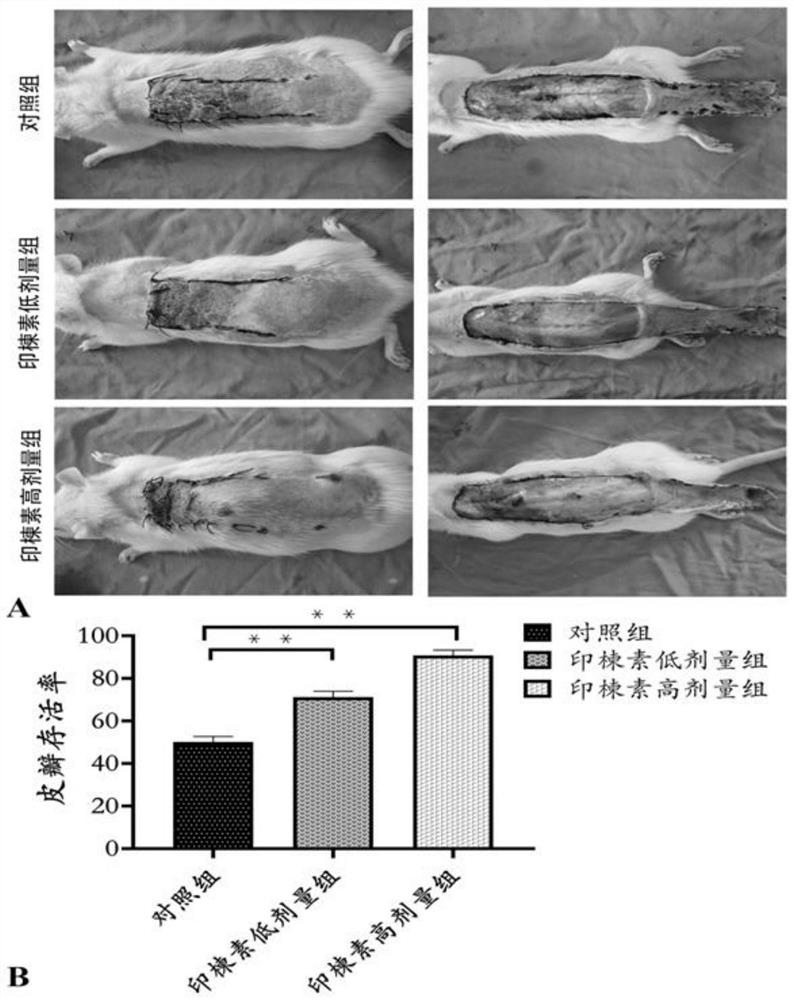The role of azadirachtin in the preparation of drugs to promote the survival of ischemic ultra-long random skin flaps
A kind of azadirachtin and ultra-long technology, applied in the direction of drug combination, antipyretics, pharmaceutical formulations, etc., can solve the problems of skin flap tissue nutrition and metabolism disorders, failure of skin flap transplantation surgery, low survival rate of skin flaps, etc., to achieve Effects of reducing skin flap cell damage, increasing blood vessel density and blood flow, and reducing edema
- Summary
- Abstract
- Description
- Claims
- Application Information
AI Technical Summary
Problems solved by technology
Method used
Image
Examples
Embodiment 1
[0030] Example 1: Detection of skin flap survival area ratio and skin flap survival status
[0031] From 1 to 7 days after operation, the color, texture, tissue elasticity and hair growth or necrosis of rat skin flaps were observed daily with naked eyes and recorded. On the 7th day, under anesthesia, the rats in each group accurately measured the survival and necrosis area of the skin flap with transparent paper, cut it into two parts, the living part and the dead part, and weighed them with electronic scales. Calculate the percentage of flap survival area [flap survival area transparent paper mass ÷ total flap surface area transparent paper mass × 100%].
[0032] Flap necrosis criteria: the color of the flap is black, the tissue retracts, the elasticity is poor, the texture is hard, and the cut tissue does not bleed. The pathological manifestations were tissue disintegration, nucleus disappearance, extensive infiltration of inflammatory cells, and focal hemorrhage.
[003...
Embodiment 2
[0034] Example 2: detection of skin flap neovascularization
[0035]Using laser Doppler blood flowmeter to detect the neovascularization of skin flap is a device that uses the principle of laser Doppler to monitor the blood perfusion of microcirculation in animals or human tissues. The laboratory of this subject has the instrument and supporting operating software to collect and analyze blood flow signals. On postoperative day 7, microcirculatory blood flow was measured using a laser Doppler flowmeter. Six rats per group were anesthetized and scanned using a Laserflo BPM (Vasamedic, Saint Paul, MN, United States) with a 15 cm x 15 cm area and 256 x 256 pixels. LDBF generally provides deeper penetration, enhancing visualization of small blood vessels beneath the tissue surface, and is ideal for angiogenesis assessment. The blood supply was visualized using strong LDBF signals (green, yellow and red), and its area was quantified using ImageJ software (NIH, Bethesda, MD, United...
Embodiment 3
[0039] Embodiment 3: Histological detection
[0040] Seven days after the operation, the rats were sacrificed, and tissue samples were cut from the middle of the flap, fixed in 4% (v / v) paraformaldehyde for 24 hours, and embedded in paraffin for transverse sectioning. Sections (4 μm thick) were mounted on poly-L-lysine-coated slides for H&E staining. Under a light microscope (20X magnification), the thickness of granulation tissue, edema and angiogenesis were observed. In addition, the neutrophil density and the number of microvessels per unit area ( / mm2) were calculated for each group.
[0041] The result is as Figure 7 As shown, the high-dose and low-dose groups of azadirachtin showed obvious subcutaneous fibroblast proliferation, thin granulation tissue, mild tissue edema, and obvious diffuse subcutaneous hemorrhage. The control flaps were thicker, had less fibroblast proliferation and neovascularization, and more severe edema and inflammatory cell infiltration ( Figu...
PUM
 Login to View More
Login to View More Abstract
Description
Claims
Application Information
 Login to View More
Login to View More - R&D
- Intellectual Property
- Life Sciences
- Materials
- Tech Scout
- Unparalleled Data Quality
- Higher Quality Content
- 60% Fewer Hallucinations
Browse by: Latest US Patents, China's latest patents, Technical Efficacy Thesaurus, Application Domain, Technology Topic, Popular Technical Reports.
© 2025 PatSnap. All rights reserved.Legal|Privacy policy|Modern Slavery Act Transparency Statement|Sitemap|About US| Contact US: help@patsnap.com



